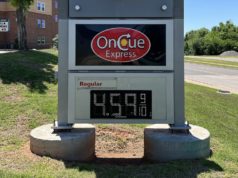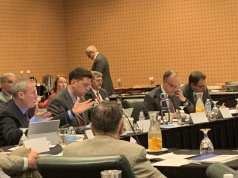
TULSA — My primary productive activity these days is Uber driving for two grandchildren (for which I keep detailed accounts with the expectation of being fully compensated some day). Till that day comes, I depend on monthly deposits from two “defined benefit” pension plans, namely Social Security and the Oklahoma Teachers Retirement System (OTRS).
Defined benefits and defined contributions, defined
Pension plans generally can be classified as either a “defined benefit” or as a “defined contribution” plan. Social Security and OTRS are defined benefit pensions, meaning the determination of the resulting pension benefits paid out is based on a formula that is not directly related to the contributions made. The formula for OTRS is very simple and typical of state and local public pensions: number of years of service multiplied by an ending average salary (either three or five years’ worth). Social Security is more complicated but essentially based on the highest 35 years of (inflation adjusted) earnings, making it more difficult to leverage with a few high-earning years.
By contrast, saving for retirement through a company 401k plan or your own IRA are examples of defined contribution plans. Money goes into your account and generates investment earnings along the way that are added back in. Upon retirement, what you are paid is determined by how much your account is worth and continues to earn. Unlike the defined benefit plan, there is no promise of an amount certain at the end of the rainbow.
So, Social Security and OTRS are public pension plans where participation is mandated, but the individual contributions made may – or may not – be sufficient to finance the amount to be paid out in benefits. If the amounts contributed are insufficient, then who is left holding the bag?
Social Security lacks the legal recourse of OTRS
This is where the two plans appear to differ: By Oklahoma case law, the promises OTRS makes to its vested participants (mostly teachers) are enforceable obligations of the State of Oklahoma. Social Security, apparently, lacks the same legal commitment. The plain language of the recently released Social Security Trustees 2017 Report states that if, in the future, funds are insufficient to pay full benefits, then a prorated amount is paid. I have read no mention of any right to legal recourse to enforce a Social Security promise in the same way a retired teacher could pursue the State of Oklahoma.
Social Security like a Ponzi scheme, but OTRS makes sense
The two plans also differ in what happens to the money that participants pay in. In the case of OTRS, that money is put to work according to the investment policy of its board of trustees. OTRS receives about $1 billion each year in employee contributions, which, combined with earnings of about $2 billion in FY 2017, was sufficient to pay all benefits required and to add substantially to its fully invested assets, which now total over $15 billion. This is a logical, though complicated, business model that makes sense.
By contrast, Social Security resembles a Ponzi scheme. From the beginning, it was designed to rely primarily on the cash flow from active participants paying directly for active retirees. The plan worked well when the ratio of covered workers to beneficiaries was 3.3 at the time my father retired in the mid-1980s. It was also maybe sustainable at 2.8, when we oldest Baby Boomers started retiring en masse a couple of years ago. It clearly will not work in just a few years, when the worker-retiree ratio is projected to be 2.1.
ROIs differ greatly between Social Security, OTRS
Also, Social Security’s investment earnings fail to enhance its funding much. While not guaranteed, OTRS projects a very reasonable return of 7.5 percent annually on its assets of $15.4 billion, meaning it expects investment income to exceed, on average, the approximately $1 billion dollars in contributions and state revenue it collects each year. Eventually, its investment income will be sufficient to fully fund the benefits paid out by the system to retirees.
By contrast, for FY 2016, the Social Security trust fund for retirement benefits earned about 3.2 percent (or about $89 billion) on its $2.8 trillion in assets, which is way less than the almost $762 billion in benefits paid out. The return is so low because the trustees are required to purchase U. S. Treasury securities, i.e. our national debt, which now exceeds $20 trillion.
Social Security resembles a kind of social welfare
So, in effect, the modest cumulative surplus in contributions to Social Security in excess of benefits paid out over the years is used to finance our government’s excess spending for other purposes. No private or public pension fund manager would stay employed with such a conservative investment strategy of buying only low-yield government securities. There are policy reasons for this arrangement, however, such as: Imagine a political party in power deciding how to spread around almost $3 trillion dollars. Still, it does result in a steeper hill for Social Security to climb than what a state pension plan like OTRS faces.
Bottom line: Social Security is not a “pure” defined benefit retirement plan because it has characteristics of a social welfare program as well. We all contribute, and our benefits are related to how much and how long we’ve contributed, but contributions and benefits are politically determined social welfare policy, with the deciders being Congress and the President.
OTRS should provide state about $500 million by 2033
Here’s the data on OTRS, updated through the most recent actuarial analysis report (see my post, Fouling Our Nest Egg, for more detailed information):
(numbers in millions)
| OTRS | MVA | AVA | AAL | UAAL | AV% | MV% | Years | |
| 2007 | 9,293 | 8,422 | 16,024 | (7,603) | 52.6% | 58.0% | 21.6 | |
| 2008 | 8,634 | 9,257 | 18,347 | (9,090) | 50.5% | 47.1% | 54.4 | * |
| 2009 | 7,227 | 9,439 | 18,951 | (9,512) | 49.8% | 38.1% | ∞ | |
| 2010 | 8,352 | 9,567 | 19,981 | (10,414) | 47.9% | 41.8% | ∞ | |
| 2011 | 10,156 | 9,961 | 17,561 | (7,600) | 56.7% | 57.8% | 22 | ** |
| 2012 | 10,195 | 10,190 | 18,588 | (8,398) | 54.8% | 54.8% | 22 | |
| 2013 | 11,810 | 10,861 | 18,973 | (8,112) | 57.2% | 62.2% | 17 | |
| 2014 | 14,229 | 12,369 | 19,576 | (7,207) | 63.2% | 72.7% | 11 | |
| 2015 | 14,405 | 13,772 | 20,693 | (6,921) | 66.6% | 69.6% | 14 | |
| 2016 | 13,814 | 14,578 | 21,260 | (6,682) | 68.6% | 65.0% | 17 | *** |
| 2016 | 13,814 | 14,578 | 22,193 | (7,615) | 65.7% | 62.2% | 23 | *** |
| 2017 | 15,463 | 15,516 | 22,054 | (6,538) | 70.4% | 70.1% | 17 |
* COLAs up from 1% to 2%
** COLAs ended
*** Investment-return assumption changed from 8% to 7.5%
My favorite column is “Years,” which estimates how many years till the system is fully funded. At that time, the state’s catch-up payments of over $500 million per year can end, being now 17 years (see Table 1 or Executive Summary of this report). This pretty good news largely results from passage of the Oklahoma Pension Legislation Actuarial Analysis Act in 2006, which essentially made it very hard for the Legislature to increase pension benefits without funding the cost. It ended the frequent practice of granting benefit increases – like Social Security’s annual cost-of-living adjustment (COLA) – and caused the OTRS funding period to go from “infinite” or never in 2010 to a respectable 22 years in 2011. Unless intervening legislatures fail to stay the course, this means that, in about 2034, Oklahoma’s governor will likely announce the full funding of the state’s largest public pension plan AND make recommendations of what to do with about a half billion in annual revenue no longer needed to pay for past promises. It will be a dividend for our state well-earned.
Social Security headed the other way
The Trustees’ 2017 Report, just released, predicts that the Trust Fund will be out of money in about 16 years, and, without intervening action (benefit reductions or funding increases), all retirement benefits will be reduced. This impending financial disaster has been known since the reality of the Baby Boom generation’s numbers were known, and more than one blue-ribbon commission has studied the problem and recommended actions that would head off the disaster, always emphasizing the importance of acting sooner than later. It is a policy failure that should embarrass every member of Congress, current and past administrations.
It also means I will indirectly collect for my summer Uber services for my grandchildren because they and their generation will pay and pay and pay throughout their working lives so my benefits keep flowing.






















